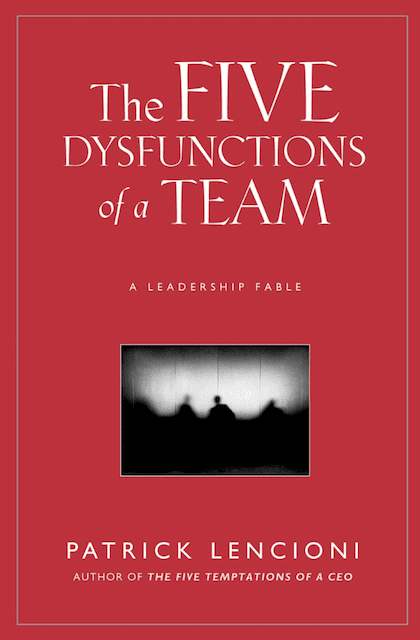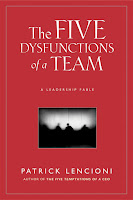Dysfunction

I felt enlightened and empowered after reading The Ideal Team Player, and so I started conversations with our human resources consultant, Laura Purswell, and with Beth Morrow, our organizational behavior coach, on the subject. Both pointed me towards Lencioni’s preceding book, The Five Dysfunctions of a Team. 
Of course, Amazon Prime is my friend, so a copy was on my desk the next morning. But the reading would have to wait until the weekend.
This one was only a slightly slower read. Mixed in with family time and social activities – and naps during football games – this book took me until sometime Sunday evening to finish. And once again, I was not disappointed.
While The Ideal Team Player gave me insight into individual behaviors, The Five Dysfunctions helped me to understand better how those behaviors were impacting teamwork and the work environment.
As backdrop, over the last year NMAAM’s staff had doubled. In so doing, the team had changed from a vertical one (where I had only one direct report) to a flatter one (where I had several). Although still a small group, with far less than 20 employees, the team dynamic had changed materially. The family feel that we’d enjoyed previously had become competitive, and the “all for one” spirit we’d enjoyed had pivoted towards more than occasional finger-pointing amongst colleagues. And in the midst of it all, there I am as the CEO alternatively oblivious and baffled.
What I had noticed consistently was that people weren’t having as much fun and didn’t seem to be as committed to the work or the mission of the museum. Work quality suffered and wasn’t as timely, and I was spending more time refereeing disagreements amongst grown people than I thought was appropriate.
Of course, all of this was coming about when we could least afford it. Every passing day brings the museum opening closer, which means that every decision and deliverable is more important today than it was yesterday.
This situation needed to be fixed. Things getting worse wasn’t an option, and things getting better would make everyone’s life easier, job enjoyment greater and project results better. This is why my man Patrick had become my new best friend.
In The Five Dysfunctions, Lencioni highlights that the challenges with a team working together boils down to:
· An absence of trust (invulnerability)
· Fear of conflict (artificial harmony)
· Lack of commitment (ambiguity)
· Avoidance of accountability (low standards) and
· Inattention to results (status and ego)
Once again, I saw my teammates and my work place in the parable that Lencioni used to highlight these detrimental characteristics. In my teammates I was routinely seeing blame shifting and missed deadlines, rather than acknowledgement that a mistake was made or that someone was unsure how to complete the task. I was experiencing a steady stream of frustrated folks in my office who had no issues with one another at all in management meetings. I was even seeing standards  lowered or goals changed in order to claim success rather than admit failure or a shortcoming.
lowered or goals changed in order to claim success rather than admit failure or a shortcoming.
When taken together this is a recipe for allowing the organization to miss its goals and to permit each individual to be confident that it was someone else’s fault. Of course, when NMAAM fails to raise the needed funds or to open on time and within budget there is only one place that the board of directors will look for explanation and accountability – and none of my direct reports will be in that meeting.
Conversely, I knew that a high performing team could make the work easier and much more fun. I knew that we could deliver a first-class product that would excite the nation. And I was even confident that we could exceed our fundraising targets.
But getting there from here would not be simple, nor straightforward. With that understanding and what I’d learned from The Ideal Team Player, I had enough information to get to work. As I thought about next steps, to my surprise, it seemed that the first thing that I needed to do was to schedule a series of meetings.
A golf outing, a management retreat, increased frequency of one on one meetings with my direct reports, and a regular schedule of meetings with the team as a whole all needed to be calendared. Common wisdom is that having too many meetings is the opposite of getting work done. Of course, that can be the case, but meetings, or spending time together, is also the only way to build a high-performing team. There simply is no substitute. In our case, my objective was to build trust, dispense with artificial harmony by encouraging constructive conflict, and to begin to focus the group on results.
Additionally, I took a chapter out of the world of consumer-packaged goods and developed a comprehensive schedule of objectives and goals for the company and each of its departments (“OGSM’s” – objectives, goals, strategies, and measures). The OGSM’s would address accountability and ambiguity, and all of this would be worked on in the wave of meetings that I’d scheduled.
There is much more that ca be said about the Five Dysfunctions of a Team and what it takes to overcome them but suffice it to say that the work is just beginning. Further, my role as leader is as important as any of my colleagues. Not only must I be consistent, but I have some habits of my own that need to be broken if I am to be effective in making the team more productive.
Lencioni points out that the leader must be vulnerable first, allow healthy conflicts to unfold without stepping in, be willing to make a wrong decision, encourage the team to hold one another accountable and set a tone for focusing on results. In their own ways and words, my team has asked that I do some of the same things to be a better leader for them.
Let’s give it a shot.
